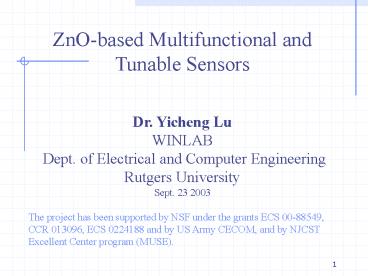ZnObased Multifunctional and Tunable Sensors - PowerPoint PPT Presentation
Title:
ZnObased Multifunctional and Tunable Sensors
Description:
The project has been supported by NSF under the grants ECS 00-88549, ... The total misfit accommodated by strained regions. 4. Advantages of MITSAW Biosensors ... – PowerPoint PPT presentation
Number of Views:127
Avg rating:3.0/5.0
Title: ZnObased Multifunctional and Tunable Sensors
1
ZnO-based Multifunctional and Tunable
Sensors Dr. Yicheng Lu WINLAB Dept. of
Electrical and Computer Engineering Rutgers
University Sept. 23 2003 The project has been
supported by NSF under the grants ECS 00-88549,
CCR 013096, ECS 0224188 and by US Army CECOM, and
by NJCST Excellent Center program (MUSE).
2
Introduction ZnO Materials for Sensors
- II-VI compound semiconductor
- Direct bandgap, with Eg ?3.32 eV.
- Bandgap engineering alloy with Cd or Mg to
tailor bandgap from 2.8eV to 4.0eV. - Multi-functional
- Hexagonal wurtzite class crystal gt
piezoelectricty with large coupling coefficient. - Large and fast photoconductivity gt optical
sensing. - Al or Ga doping gt transparent conductive oxide.
- Li Mg doping gt ferroelectric.
- Alloyed with Mn gt magnetic oxide semiconductor.
- Integrate electrical, optical and piezoelectrical
properties gt MITSAW chip for sensor technology
3
Structure of ZnO Films on r-sapphire
- The as-grown film on r-sapphire is dense and very
smooth - The c-axis of ZnO is in the plane of the film
- Interface is sharp and semi-coherent
- The total misfit accommodated by strained regions
4
Advantages of MITSAW Biosensors
- ZnO/r-Al2O3 structures high frequency low loss
operation - MITSAW biosensor
- resettable and tunable, therefore increasing
the sensors lifetime - Dual SAW modes operation (gas-phase and
liquid-phase sensing) - Operating in UV and acoustic mode (SAW and BAW),
increasing the accuracy. - It can be integrated with Si IC through SOS
technology sensor-on-chip lab-on-chip
MUSE biosensor chip based on MITSAW technology.
5
MgxZn1-xO-based BAW Sensor
- Operating at high frequency.
- Can be integrated with electronic circuits on
silicon chip gt smart sensor. - An array of micromachined thin film resonators
(TFRs) will selective coatings. - Dramatically improve sensor reliability and allow
detection and measurement of multiple chemicals
simultaneously.
6
Zero-Power Remote Wireless Sensors
- Base station sends interrogation pulse.
- The antenna picks the pulse the SAW IDT launches
a wave packet. - The wave packet travels across the delay path, is
reflected by the reflecting array. - The reflected wave generates a signal at the IDT.
- The antenna send a response pulse.
- 2DEG bias determines acoustic velocity, hence
response delay time. - Thus the device is a wireless read-out element
for a voltage-generating sensor, wireless tags,
etc. - Application for wireless and networked sensors
for homeland security.
7
MgxZn1-xO-based UV Sensor
- Advantages
- Wide and direct band gap (3.3eV)
- Eg tunable from 3.3 to 5.8 eV by alloying ZnO
with MgO to form MgxZn1-xO. - Large photoresponse
- High photoconductivity
- Applications
- DNA sensors for bio defense
- Sensors for missile defense
- Flame detection
8
Nanostructured Biosensors
- ZnO nanotip and nanotip arrays
- Binding sites for biomolecules, such as DNA
- High device density
- Fast response
- ZnO biosensors will be used to detect RNA-DNA,
DNA-DNA, protein-protein, protein-DNA, and
protein-small molecules interactions. - Experiments have proved the ZnO nanotips greatly
enhance the immobilization of DNA - and protein molecules.
- Examples
- proteins - DNA-RNA
- whole bacterial cells - tissues
9
Broad Impact
- Multifunctional and tunable sensors have a
variety of very important practical applications - health care (medical and genetic diagnostics)
- environmental monitoring (control of pollution
and detection of hazardous chemicals) - food analysis (detection of ingredients,
contamination etc.) - detection of biological warfare agents.
- As an example, a world market for over trillion
sensors by 2010 is estimated, growing to 3-5B
in 2005. - The research results strengthen nations
technology capabilities in the emerging area of
multi-mode, multifunctional biological and
biochemical sensors - Accelerate deployment of biochemical sensor
networks, secure wireless systems for national
and state-level public infrastructure uses such
as environmental monitoring, hospital management,
and homeland security.
10
Achievements of ZnO Research at Rutgers
- High quality MOCVD ZnO and MgxZn1-xO thin films
on R-Al2O3 and SiO2/Si. - Low loss ZnO/R-Al2O3 SAW devices.
- The first high speed ZnO MSM photoconductive and
Schottky UV photodetectors. - The first optically addressed normal incidence
ZnO UV high contrast modulator. - The first ZnO Schottky devices on R-Al2O3.
- Novel ZnO nanostructures.
- Novel MITSAW chip technology.
- 5 patents awarded and 8 more pending































